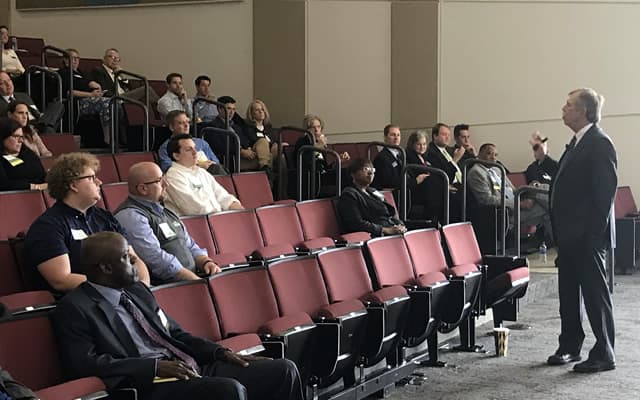
The North Carolina economy will continue to grow in 2018, especially in metro areas along the I-85 corridor, UNC Charlotte professor and economist John Connaughton said.
Connaughton stated that one-quarter of the counties represent the majority of the economic recovery in the state. In particular, the Metropolitan Statistical Areas of Charlotte and Raleigh represent around 85 percent of the state’s GDP and more than 50 percent of the state’s employment growth during the economic recovery from the Great Recession.
In 2018, Gross State Product (GSP) is expected to reach a level of $564,797.50 million. Real (inflation-adjusted) GSP is expected to increase by 2.2 percent over the 2017 level. This growth in 2018 would follow the 2 percent real growth in North Carolina GSP recorded in 2017, said Connaughton during the Barings/UNC Charlotte Economic Forecast at UNC Charlotte Center City.
Gross State Product (GSP) is expected to reach a level of $541,884.60 million in 2017. The recently released Bureau of Economic Analysis quarterly state GDP shows that for the first quarter of 2017, North Carolina GSP decreased by an annualized real rate of 0.5 percent. During the second quarter, GSP is increased by an annualized real rate of 2.7 percent. In the third quarter, GSP is expected to record an annualized real growth rate of 2.2 percent. In the fourth quarter of 2017, GSP is expected to grow by an annualized real rate of 2.1 percent.
“During the first quarter of 2017, the North Carolina economy experienced a slight decline in GSP compared to a modest 1.2 percent first quarter growth experienced by U.S. GDP. The state’s economy rebounded during the second quarter recording a 2.7 percent increase,” Connaughton said.
He added, “During the third and fourth quarters of 2017 both the North Carolina and the U.S. economies should continue to expand at around a 2 percent rate. This would be consistent with the expected long-term growth forecast by the Congressional Budget Office (CBO). The CBO June 2017 Economic Outlook forecasts the average GDP growth between 2017 and 2027 to be at 1.8 percent per year.”
Seasonally adjusted nonagricultural employment in North Carolina is expected to reach 4,441,000 persons in December 2017, an increase of 1.3 percent over the employment level in December 2016. The state is expected to add 58,300 net jobs during 2017, an increase of 1.3 percent.
The sectors with the strongest employment increases in 2017 are business and professional services at 4 percent, educational and health services at 2.6 percent and hospitality and leisure services at 2 percent.
The United States started 2017 with an unemployment rate of 4.8 percent, which has declined to 4.1 percent by October. North Carolina started the year with a 5.3 percent rate of unemployment, which also declined to 4.1 percent by October. By December, the North Carolina unemployment rate is expected to be around 4 percent.
“Positive economic growth in 2018 would represent the ninth consecutive year of economic growth for the North Carolina economy. The potential U.S. tax reform could impact the economy long term, especially corporate tax reform,” Connaughton said. He presented his quarterly forecast as part of the Barings/UNC Charlotte Economic Forecast organized by Barings and the UNC Charlotte Belk College of Business.